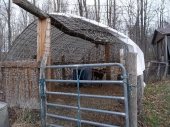
 5
5




I make a Maple Syrup instructional movie! Check it out HERE
SKIP books, get 'em while they're hot!!! Skills to Inherit Property
See me in a movie building a massive wood staircase:Low Tech Lab Movie
 3
3




 4
4




A piece of land is worth as much as the person farming it.
-Le Livre du Colon, 1902
 4
4




No man is an island.
 4
4




 2
2





A human being should be able to change a diaper, plan an invasion, butcher a hog, conn a ship, design a building, write a sonnet, balance accounts, build a wall, set a bone, comfort the dying, take orders, give orders, cooperate, act alone, solve equations, analyze a new problem, pitch manure, program a computer, cook a tasty meal, fight efficiently, die gallantly. Specialization is for insects.
-Robert A. Heinlein
 5
5




I make a Maple Syrup instructional movie! Check it out HERE
SKIP books, get 'em while they're hot!!! Skills to Inherit Property
See me in a movie building a massive wood staircase:Low Tech Lab Movie
 1
1








 3
3




Mick Fisch wrote:
Back when I was a teenager people would nail up plywood with a bunch of 16 penny nails sticking out to their cabin doors and windows when they had to leave for a while (or if it was a seasonal cabin). It worked most of the time, but a determined bear could still find a way in. Laying them on the ground is an idea I haven't heard of before. It might work, but the plywood won't last too long, laying on the ground.
Pecan Media: food forestry and forest garden ebooks
Now available: The Native Persimmon (centennial edition)
 1
1




A human being should be able to change a diaper, plan an invasion, butcher a hog, conn a ship, design a building, write a sonnet, balance accounts, build a wall, set a bone, comfort the dying, take orders, give orders, cooperate, act alone, solve equations, analyze a new problem, pitch manure, program a computer, cook a tasty meal, fight efficiently, die gallantly. Specialization is for insects.
-Robert A. Heinlein
 3
3




Weeds are just plants with enough surplus will to live to withstand normal levels of gardening!--Alexandra Petri
 1
1




I make a Maple Syrup instructional movie! Check it out HERE
SKIP books, get 'em while they're hot!!! Skills to Inherit Property
See me in a movie building a massive wood staircase:Low Tech Lab Movie




 4
4





![Filename: CLOWN.jpg
Description: Bear Deterrent [Thumbnail for CLOWN.jpg]](/t/134247/a/99570/CLOWN.jpg)
'Every time I learn something new, it pushes some old stuff out of my brain.'
 9
9




This is all just my opinion based on a flawed memory

 1
1




Catherine Windrose wrote:
Could a bear climb a nail studded log? Would 2" nails be short enough to not become a nail ladder, yet long enough to be uncomfortable, and not so long as to do serious injury? Are there other critters drawn to honey that would be able to climb up the log if the sides were studded with nails?
![Filename: cache.jpg
Description: trapper cache [Thumbnail for cache.jpg]](/t/134247/a/99581/cache.jpg)
Pecan Media: food forestry and forest garden ebooks
Now available: The Native Persimmon (centennial edition)
 2
2




![Filename: beehive-fence.jpg
Description: [Thumbnail for beehive-fence.jpg]](/t/134247/a/99586/beehive-fence.jpg)
![Filename: scary-clown.jpg
Description: [Thumbnail for scary-clown.jpg]](/t/134247/a/99587/scary-clown.jpg)
Argue for your limitations and they are yours forever.










 2
2




"Never doubt that a small group of thoughtful, committed citizens can change the world; indeed, it's the only thing that ever has."-Margaret Mead "The only thing worse than being blind, is having sight but no vision."-Helen Keller
 1
1




I make a Maple Syrup instructional movie! Check it out HERE
SKIP books, get 'em while they're hot!!! Skills to Inherit Property
See me in a movie building a massive wood staircase:Low Tech Lab Movie
 2
2




 3
3




Argue for your limitations and they are yours forever.
 1
1








 3
3




 1
1




A build too cool to miss:Mike's GreenhouseA great example:Joseph's Garden
All the soil info you'll ever need:
Redhawk's excellent soil-building series






 1
1




Some places need to be wild
 4
4




No man is an island.
 3
3




"Them that don't know him won't like him and them that do sometimes won't know how to take him... he ain't wrong, he's just different and his pride won't let him do the things that make you think he's right"
 1
1




I make a Maple Syrup instructional movie! Check it out HERE
SKIP books, get 'em while they're hot!!! Skills to Inherit Property
See me in a movie building a massive wood staircase:Low Tech Lab Movie
 1
1




Nothing is foolproof to a sufficiently patient fool!
I hate people who use big words just to make themselves look perspicacious.
 1
1




Lorinne Anderson: Specializing in sick, injured, orphaned and problem wildlife for over 20 years.




 1
1




 1
1





 1
1




“Uncertainty is an uncomfortable position. But certainty is an absurd one.”
― Voltaire
 1
1








Joshua Frank wrote:@Mike-Haasl: did you ever try your idea? Did it work?
I make a Maple Syrup instructional movie! Check it out HERE
SKIP books, get 'em while they're hot!!! Skills to Inherit Property
See me in a movie building a massive wood staircase:Low Tech Lab Movie
 2
2





| I agree. Here's the link: http://stoves2.com |




